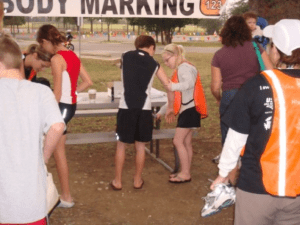
I know the word DON’T is strong and can sound mean, but that’s really not my intent. We have just witnessed some “uncomfortable” situations take place at triathlons over the years and hate to see them repeated. By writing these DON’TS, I’m trying to give you tips so that you, your athlete, your kids, and the race community have a very smooth day.
We’ve actually taken the kids to David’s triathlons for years and love it, but we have also seen many parents and grandparents struggle through the day. It doesn’t have to be that way. I actually urge you to bring the kids to the races. You just need to take a deep breathe and be prepared, which is why I’m writing this for you.
And, as we always say, it’s location, location, location…Pick the right race venue and your day will be so much more pleasant. So, here you go:
Top 10 Triathlon DONT’S When You Have Kids In Tow…
- DON’T assume someone else is watching your kids! Just because there are so many people around and everyone is here for the same reason, doesn’t mean someone else is paying attention to your kids. We’ve seen kids running around with no apparent supervision. It is your responsibility to know where your children are at all times. Remember, you are always on duty!
- DON’T assume the race venue is stroller friendly. Not every race is created the same. The race course is designed for the triathlete and most are very spectator-friendly. There have been many times I have helped friends and fellow spectators carry a stroller up or down stairs, over a wall, and up a hill. I would also highly recommend a runner stroller or a wagon if you have or can get your hands on one.
- DON’T forget to bring lots of bottled water. There are water stops all along the bike and run course for the athletes, but not for the spectators. And, finding a faucet to refill your water bottle or a store to buy water at can be a bit tricky sometimes. No matter how cute your kid is, please don’t let them run up to an aid station and take a water! Yes, I have seen this done several times, but once a child blocked a runner and the runner tripped and fell. Not cool and obviously can be dangerous.
- DON’T assume that because the race course on-line said you could cross the street in one spot, that’s the way it will be on race day. Be prepared to take a detour. For example, one year at Ironman Mont Tremblant, you could easily cross the street a little down from swim out. The next year the course for spectators changed and they put in a cat walk up the street. It was a great idea and worked well, but took a bit longer than the year before. Also, if you had a stroller it was impossible, you needed to head up the street to cross.
- DON’T let go of your little kids’ hands near the run course. PLEASE hold their hands. I have seen kids tripped over and hurt. It is not the runner’s fault- for goodness sake this is their race. Keep your child close and hopefully everyone safe.
- DON’T assume every restaurant will be open. Plan your meals, especially with the kids. We have found most local restaurants are open and excited to have the business, but some do close. Be prepared when you have hungry kids and have a plan, including carrying plenty of snacks.
- DON’T lie about your kids age and sign them up to volunteer. And, don’t assume just because your child is the right age they are ready for every volunteer job. Volunteers make the day for the triathlete. We all like to think our kids can handle the responsibility, but volunteering at a race is not for every kid and it does have requirements for the well-being of your child and the athletes. When your child is old enough to volunteer, pick the spot carefully. For example, do not do bike catching or bike aid stations until they are much bigger; I mean like young adults. Remember, they are catching bikes that can cost upwards of $15,000! The bike aid stations can be dangerous and one wrong move and your child can be hurt or an athlete can be knocked off their bike. We have seen both.

- DON’T assume your athlete will stick to their race day plan- things happen both good and bad. I always plan on arriving at my next “hot spot” 30 minutes before my husband says he will be there. He often underestimates his day. Plus, when the kids were little, I always left myself an extra 20 minutes to get to each place as opposed to when I was alone. Then, there are the not so good race days…the day goes longer, you don’t have good internet, and are having difficulty tracking your athlete. You watch for your athlete, start to panic, are watching the kids and yes, it has happened, my athlete spots me (thank goodness) because otherwise I would have missed him. Make sure you also always have a plan post race just in case anything happens or you get separated at the finish line. Pick a meeting place ahead of time.
- DON’T push the kids beyond their limit. It is not worth it and everyone will be cranky.
- DON’T forget to take down time. This is the single most important part of the day, especially at full distance races. Find the pool, take a nap, sit down and eat lunch, and/or plan a fun activity for the kids to do with you. It may be your athlete’s day, but spectators need love, too!
– DANA
WHAT DON’TS HAVE YOU SEEN AT A TRIATHLON?

Sherry is one of the TriWivesClub and LifeDoneWell co-founders and contributes to multiple blogs. She is a former co-owner of the California Apparel News and had a career in the healthcare industry. Her passions include traveling, real food, the environment, and animal rescue/welfare. She lives a healthy lifestyle and has been a vegetarian since 1987. She and her husband are parents to two rescue pups and reside in Connecticut.













Great tips! I have seen too many overtired children and frustrated parents at both of the races I saw. BTW, we just got back from Mont Tremblant and had a blast there 🙂
Hi Anna. Isn’t Mont Tremblant gorgeous? It is such a great venue which is why we’ve been multiple times. I hope he did well or at least had fun. How was your second spectating race? Ready for more?
Oh, it was absolutely dreamy 🙂 All shades of green, sunshine, mountains and couple time 🙂 He had his best time, ever. I was so very proud! He is doing Lake Placid next (July!) and one more in the fall and he wants to retire after and return to just running… We shall see 🙂
So glad it was dreamy. Love your description. Let us know if you found a favorite thing to do or place to eat. It’s a hard sport to stay dedicated to and takes a lot out of everyone! It’ll be interesting to see what he decides.
yes yes yes. Also true for bike paths. I have this fear that one day im going to hit a wandering unsupervised child. Ah!
We’ve seen it happen and felt so sorry for the runner. Hope to never see it on the bike path. Too scary… Can’t wait to see Jurassic Park!